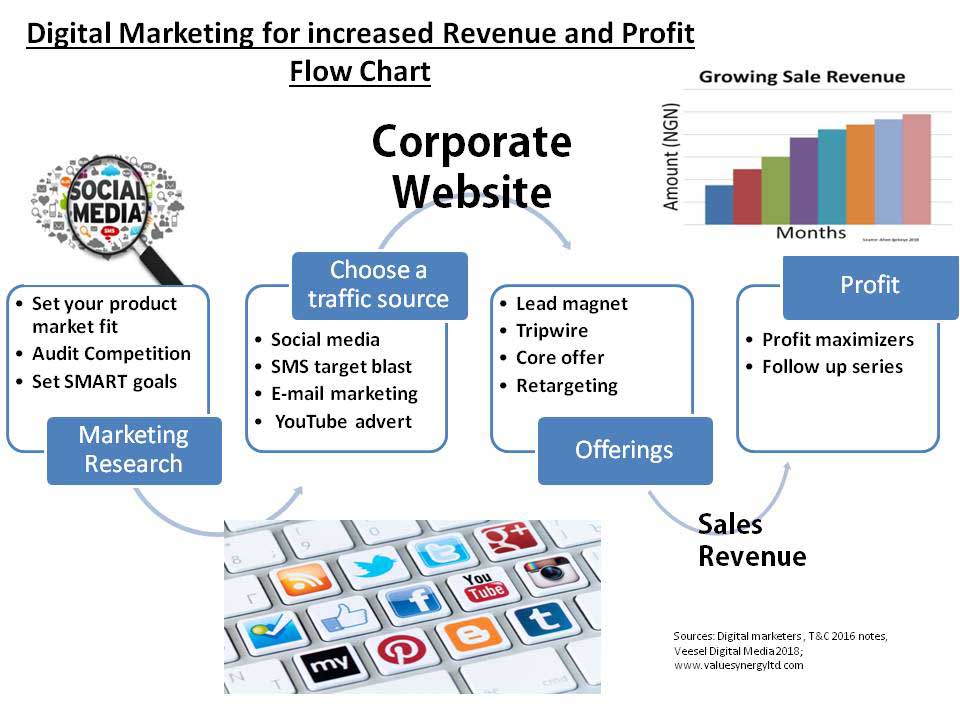A B2B product is a service rendered by a company to another company. When a business sells to another business, that relationship is said to be B2B marketing. For example, a company in marketing research and brand management will sell its market research or brand management services to another company, as a product.
For us to market our business to the market, we do the following marketing activities:
- Create a website with blog posts– for communicating our brand promise/message, telling our stories, showing our testimonies and project experiences, and educating the market on other issues related or not related to their immediate needs.
- Create respective social media handles for targeting and driving traffic to the website
- Develop a custom presentation on the customer journey of taking the qualified potential client from the pain point they have expressed, to a position of comfort and delight
- If the customer, thereafter, requests further details, then further details, similar to the one you will read below, are presented. At this point, the potential customer is convinced enough to want to test your service.
B2B Marketing Customer Journey
We now go through the basic steps in planning a brand management customer journey
This is comprised of 10 steps which are not in any particular order and mustn’t necessarily be ten steps.
- Introduction
- Market research – search for branding opportunities
- Decide your communication platform
- Decide the level of participation/brand communication
- Decide your strategy
- Set your budget
- Develop your story or message
- Create your design and graphics
- Deploy your strategy
- Get feedback
- Introduction:
The essence of marketing is brand communication. The brand essence decides the message of the communication. Brand by its nature is a ‘promise made’, so the brand spends the whole of its lifetime, keeping that ‘promise made’.
In brand communication, all efforts are geared towards developing the best message to communicate the purpose of the brand as occasions arise. This is not different in B2B marketing
In this write-up, I will be narrating my B2B marketing experience communicating with brands on different occasions with an emphasis on brand management in business-to-business relationships.
2. Market Research:
To get a good knowledge of any brand, the right questions need to be asked and answered. It all starts with the client’s brief or marketing proposal which a marketing officer needs to develop for management approval.
A clear demonstration that the brief or proposal is understood is in the quality of the questionnaire developed and used for data collection. Analysis of these data will chart the course for the development of a communication strategy for the brand. The information arrived at from the data analysis will answer questions such as the positioning of the brand, market size, brand awareness, brand acceptance, etc.
The duration of market research depends on the depth of information required and geographical coverage.
3. Communication Platform:
The brand positioning for instance will determine on what platform to communicate your brand. However, social media marketing has changed all that. All demographics are actively present on digital platforms. In any case, businesses of the feature should look towards social media content development and marketing for sustainability and ‘oxygen’ for survival. Everything and everybody have gone mobile without neither apologies or sentiments. If you’re not found on the internet through a mobile device, there is nobody for you! Whatever your brand positioning, the people you’re seeking their attention and patronage are all on the internet through mobile devices. Take your story and tell it to them on the internet, however.
4. Brand Communication/Level of Participation:
To seek clients or customers, there should be no limit to your brand communication. Traditional means of brand communication are increasingly and prohibitively expensive, and so very restrictive, especially for small businesses. The internet and social media platforms have risen to the occasion with very effective flexibility in all its ramifications, within their terms and conditions.
Brand communication strategy varies from company to company. Effective brand communication strategy starts from the qualitative user experience of the product or service. The strategy should also include quality photography and graphic designs, customer avatars which should be at the forefront of the strategy, communication channels, platforms, and opportunities.
5. Choice of Strategy:
Deciding and developing a working strategy requires high-level creativity and testing. Take for instance, if I take a brief to manage a hotel brand as a B2B product, In product knowledge research, I will find and consider the following in my strategy, (not in any particular order):
- It is a localized business
- Ambiance
- Interior décor
- Amenities
- Car parking lot
- Utilities
- Catering
- Power supply
- Room rates
- Customer service
- Supply chain management
- Branding: internal, and external signage, website, social media handles, brand communication message
- Promotional items
- Etc.
All of these the above-listed items must be in sync with the brand promise/communication. The strategy will include various sales and promotional strategies to ensure that the rooms are always fully booked. This is where internet and social media strategies will be very essential for long-term benefits.
6. Set the budget:
In organizations, marketing is business and it costs money! For the hotel example, I mentioned above, developing the facility and customizing it to respond to the brand’s promise/message cost so much money. Having a complete picture of what marketing entails in this instance, gives a clear road map for the financial strategy required to put these items in place. With the budget set and funding put in place, deploying the strategy becomes feasible.
7. Develop your message:
Knowing the customer you seek to serve is very important. It set the stage. No brand should service everybody because it will be an exercise in futility. Your customer must be defined at the beginning of your marketing. That for instant will determine the size of the rooms in the hotel mentioned in my example, the potential customer knowledge will decide other things like the ambiance, interior décor, location, amenities, utilities, luxury, room rates, etc. market research will unravel all the required data and information. All these now culminate into a message and communication for the brand.
8. Create the brand’s graphics and designs:
Nothing communicates better than photos and graphics. As mentioned in the hotel example above, the customer avatar, the luxurious lifestyle experience that the brand claims to represent must be photo and graphically expressed in all the brand’s communications. This communication must be adapted for all the channels and social media platforms to be used for communication. In all communication, the company’s brand identity, ie the company’s name and logo must be conspicuously inscribed on all brand communication items to let the market know who is communicating.
9. Deploy the strategy:
As the brand director, brand building and management is under your purview. You approve all budgets and strategies. The buck stops on your desk. At this stage, it is expected that all objectives and strategic plans have been verified okay and set for deployment. The deployment also requires creativity and testing to quickly identify what works best and what is not working. Internet and social media strategies allow for affordability and flexibility of strategy deployment.
10. Get feedback:
Using traditional communication platforms, it may take more than six months to realize that money spent on communication was money thrown down the drain and that the venture shouldn’t have taken place in the first instance. However, with digital marketing, the internet, and social media platform, you feel and see what’s working or not working in a matter of days so that the necessary tweaking can be done on the go! This makes it easy to scale what works and get maximum benefit.
Conclusion:
Marketing services and Brand development, in the context of this write-up, is a B2B product (Business-to-Business product). Using the instance of the branding of the hotel mentioned above, we rendered the consulting and branding of the hotel as one of our product lines. This is by no means exhaustive. In delivering service product customer journey, we customize creatively to fit potential client’s briefs and expectations, and also to ensure that the client is delighted at every point of the journey.
About the Author:
Afam Ijekeye is the founder and CEO of Value Synergy Ltd. He is passionate about working with and getting solutions to pain points for small and medium-sized enterprises, irrespective of the sector or industry. Personal Profile




Im extremely pleased to find this site. I wanted to thank you for your time for this particularly fantastic read!! I definitely enjoyed every little bit of it and i also have you saved as a favorite to see new information on your site.
Thanks for your encouraging comment. I trust you will also value our post on ‘Boost your Business Growth with Event Management. You may suggest topics you will want us to research and post. Encourage us more by clicking on the affiliate links to buy products on amazon online store. regards.
Happy new month! please check out our today’s deal on amazon and share it with your contacts. I appreciate you! Here is the link: https://www.valuesynergyltd.com/todays-deals/
Happy new month! please check out our today’s deal on amazon and share it with your contacts. I appreciate you! Here is the link: https://www.valuesynergyltd.com/todays-deals/